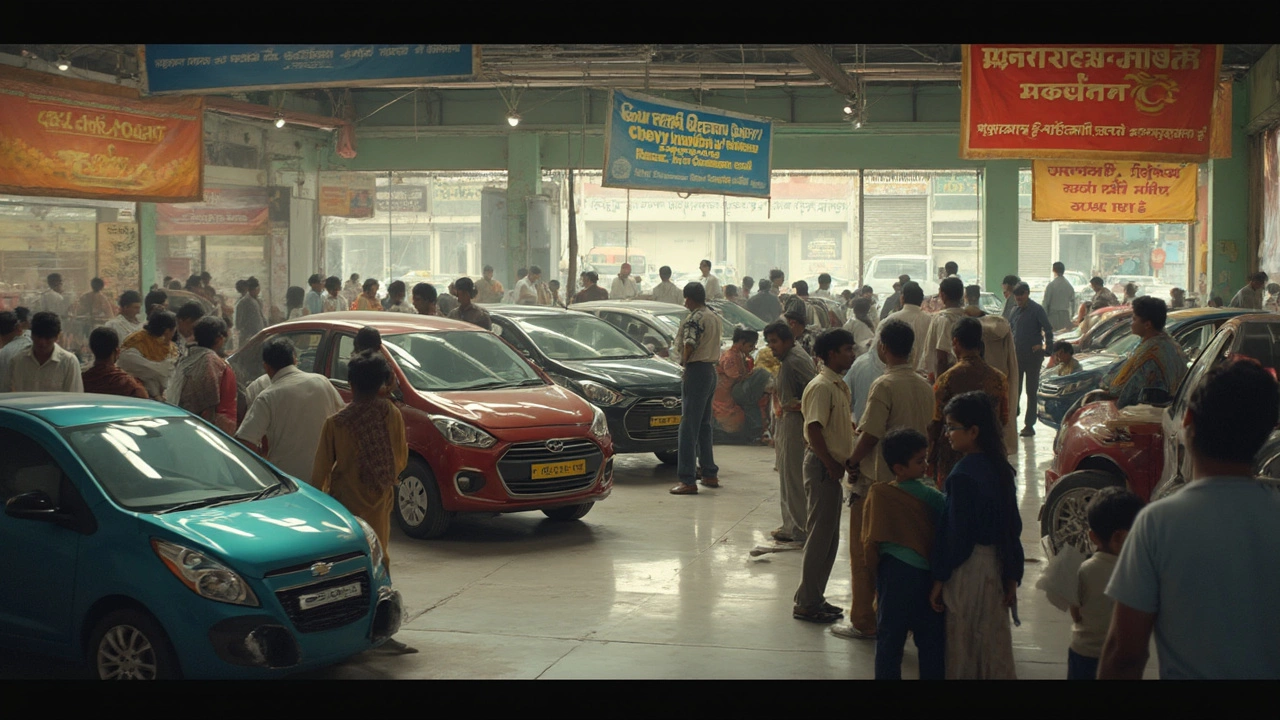If you owned a Chevrolet in India a few years back, you probably remember the day the news hit—Chevy was pulling the plug and quitting the Indian market. Dealerships were scrambling, owners were worried about repairs, and that familiar gold bowtie logo suddenly started to disappear from our streets. It wasn’t just another company quietly fading into the background. This was a pretty big deal, and honestly, it left a lot of people scratching their heads. Why would one of America’s oldest carmakers pack up and leave one of the world’s biggest car markets?
The answer isn’t simple. The story is more than about just slow sales. There’s a bigger puzzle here involving stubborn competition, pricing wars, shifting tastes, and some decisions in boardrooms that seemed smart at the time but didn’t play out so well on the Indian roads. If you’re trying to figure out what actually went down and what it means for car buyers even now, there are some lessons buried in Chevy’s story. In fact, if you look closely, there are tips for present-day buyers too—especially anyone worried about parts, servicing, or fearing a repeat of such an exit from another brand. Let’s break down what happened, without any sugarcoating or jargon, so it finally makes sense.
- Chevrolet's Arrival and Early Days
- What Went Wrong: Key Challenges in India
- Impact on Owners and Dealers
- Lessons for Car Buyers and the Industry
Chevrolet's Arrival and Early Days
Chevrolet officially set foot in the Indian car market in 2003, but their story here really began a few years earlier when their parent company, General Motors, started testing the waters with vehicles under a different badge. GM took over the struggling Daewoo India assets in 2002 and quickly began putting wheels on the road under the new Chevy brand. They weren’t just chasing headlines—they actually wanted to grab a piece of a market that was starting to take off.
They launched models like the Optra, Tavera, and Aveo. These cars tried to check all the right boxes for Indian families: affordable, strong build, and not too hard on the eyes. The Tavera especially was a hit in the taxi and fleet market, thanks to its ruggedness and seating capacity. Chevy was placing bets that these early wins would set them up as a serious contender like Maruti Suzuki, Hyundai, and Tata.
| Model | Launch Year | Key Segment |
|---|---|---|
| Chevrolet Optra | 2003 | Sedan |
| Chevrolet Tavera | 2004 | MPV (multi-purpose vehicle) |
| Chevrolet Spark | 2007 | Hatchback |
Their most popular and memorable car was the Spark, launched in 2007. Suddenly, every other TV ad break had a quirky Spark commercial, and the car actually sold pretty well in cities. At its best, Chevy hit sales of around 86,000 units in 2011. That might sound small compared to Maruti’s numbers, but it was solid for a global newcomer.
The brand also invested in local production. They set up big plants—first in Halol, Gujarat, and then in Talegaon, Maharashtra. These factories pumped out cars not just for India but also for export. At the time, this looked like a smart long-term move. They didn’t just want to be an import label. They wanted to show that Chevrolet could make in India for India.
For the first few years, things seemed to be ticking along. Chevy grew its dealer network quickly, reaching over 250 outlets by 2012. If you lived in a metro city, there was probably a Chevy showroom in your neighborhood. They played the value-for-money card hard. More features, better warranty, and aggressive financing offers pulled in first-time buyers. Indian families looking for something different from Maruti or Hyundai were beginning to pay attention.
What Went Wrong: Key Challenges in India
The most common question I get asked about the whole Chevrolet drama is: weren’t their cars good? The answer depends on who you ask, but the real reasons for Chevy’s exit go way deeper than just the product. Let’s make sense of it, one fact at a time.
First off, the competition in India is no joke. Maruti Suzuki and Hyundai basically run the show. These guys not only offer affordable prices but also know exactly what Indian families are looking for: low service costs, strong resale, and tons of service centers everywhere. Chevrolet tried hard with cars like the Beat and Spark, but it just couldn’t match those expectations—or those marketing budgets.
Another blow was pricing. Chevy’s cars were often a bit more expensive compared to similar models from Maruti or Hyundai, sometimes by as much as 10–15%. In a price-sensitive market, that’s a dealbreaker for most buyers.
Have a look at this table showing a quick price comparison at the time:
| Model | Chevy Price (INR lakhs) | Main Rival's Price (INR lakhs) |
|---|---|---|
| Beat | 4.5 | WagonR: 4.2 |
| Spark | 3.9 | Alto: 3.5 |
That extra cash upfront was hard to justify when service, resale, and brand trust were stronger elsewhere.
Let’s talk service. Owners complained – a lot – about delays getting parts and after-sales support that just didn’t keep pace with rivals. My friend Ravi waited five weeks for a clutch cable, and that wasn’t rare. The result? Fewer people willing to take a chance on Chevy the next time they shopped for a car.
There’s also the manufacturing angle. Chevy built a big plant in Talegaon, near Pune, hoping to ship out cars both locally and for export. But Indian sales stayed low, and global strategy changes in Detroit meant the focus moved away from risky new markets. GM pulled out of other countries too—South Africa, Indonesia—and it was clear India wasn’t the only spot feeling the pinch.
- They never refreshed models fast enough, while Maruti and Hyundai released updated versions almost every year.
- Marketing was lukewarm, and few people connected emotionally with Chevy ads or campaigns.
- There were rumors about shifting strategies at the top, so dealers felt left in the lurch—no confidence in long-term plans.
Put all these together—weak sales, strong rivals, higher costs, and spotty service—and you’ve got a perfect storm that pushed Chevrolet out of India. If you’re shopping for a car today, always look into a brand’s service network and model pipeline, so you don’t end up on the wrong side of a corporate shakeup.

Impact on Owners and Dealers
When Chevrolet made its exit from India in 2017, it left more than just empty showrooms — it hit both car owners and dealers right where it hurts. If you were driving a Beat, Cruze, or Enjoy, the first worry was simple: now what? And for thousands of workers at the 150+ Chevy dealerships, the future became shaky overnight.
For car owners, things got real complicated, real fast. The company promised they’d keep up with service and spare parts, but reality was hit and miss. Some service centers converted into regular workshops, but others just shut down. According to reports at the time, Chevy had about 150 service outlets after its exit, compared to nearly 400 sales points before. That’s a massive drop — suddenly, basic repair jobs or parts like bumpers and electronics took weeks instead of days.
Here's a quick look at how things changed for Chevrolet customers and dealers after 2017:
| Before Exit | After Exit |
|---|---|
| ~400 Sales Outlets | About 150 Service Centers |
| Easy parts availability | Longer wait for spares |
| Full dealership support | No new car sales, mixed servicing quality |
Dealers weren’t any better off. Many invested big money in setting up shiny showrooms — some had even taken loans. With no new cars to sell and limited support from General Motors, cash flows dried up fast. At least a dozen dealer groups moved to court, fighting for compensation and accusing GM of not honoring commitments. And trust me, it wasn’t just a handful complaining; these were big groups spread across major cities like Mumbai, Bengaluru, and Delhi.
If you’re someone who still owns a Chevrolet in India, here’s what’s worked for most:
- Stick with the remaining official service centers, but double-check for genuine parts.
- If official support dries up, connect with Chevy car clubs online. Fellow owners often share sources for reliable mechanics or spare suppliers.
- For insurance renewals or accident repairs, ask if your service center handles all paperwork. Some dropped Chevy models from their approved lists, so be alert.
It's worth repeating: once a brand pulls out, resale value plummets. A 2018 survey showed used Chevrolet cars dropping up to 20-25% in value overnight – way higher than the normal yearly depreciation. Dealers too, in many cases, had to sell off their last stock at heavy discounts just to clear out inventory.
This sudden vacuum really exposed how important after-sales support is — and what can happen to customers left in the lurch when a global automaker bails from a market as massive as India.
Lessons for Car Buyers and the Industry
The Chevrolet exit left a lot of folks wondering whether something similar could happen with other foreign brands. When a big player like this pulls out, it's a loud wakeup call for buyers, automakers, and even service centers. Here’s what everyone can take away from what happened.
First off, don’t ignore company stability when thinking about buying a car. In Chevy’s case, GM India had been reporting losses for years before the shutdown—almost ₹8,000 crore in losses just between 2013 and 2016. Dealers saw the warning signs way before the public did. So, it pays to check a company’s financial health and market presence, especially if you’re looking to buy a lesser-known or struggling brand.
Second, service and spare parts shouldn’t be an afterthought. When Chevrolet left, GM promised to continue service support. They’re still operating about 150 workshop centers as of 2024, covering smaller cities too. But, let’s not sugarcoat it—some owners face wait times or higher costs for certain parts. If you drive a car from a relatively new or shrinking brand, ask the dealer direct questions:
- Do they have local spare part stocks?
- How long is the guaranteed support period?
- Is the service network shrinking in your area?
For the industry, the lesson is clear: ignore local tastes at your own risk. Chevrolet launched cars like the Aveo, Optra, and Spark when buyers were shifting to hatchbacks and compact SUVs. Maruti, Hyundai, and later, Tata, gave the Indian buyer what they really wanted—budget-friendly, fuel-efficient, low-maintenance cars. Chevy’s fewer refreshes and slow feature updates didn’t help either.
If you’re worried about stuck resale value, here’s a stat that stings: resale prices of Chevrolet cars dropped by an extra 10-20% after the exit. Compare that to Maruti or Hyundai, where resale values generally hold up better because of supply chain strength and long-term service guarantees.
| Brand | Service Centers (2024) | Resale Value Drop After Exit |
|---|---|---|
| Chevrolet | 150 (down from 300+) | 10-20% |
| Maruti Suzuki | ~4,000 | Minimal |
| Hyundai | ~1,300 | Minimal |
So, here’s the bottom line for car shoppers: ask more questions, look beyond the sticker price, and don’t get blinded by discounts on slow-selling brands. If you’ve already got a Chevrolet or another discontinued model, don’t panic. Stock up on critical spare parts when you can, build a good local mechanic network, and keep your documents sorted for better resale value later.








Write a comment